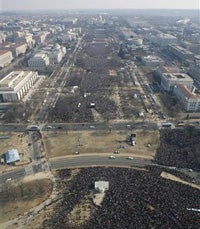 |
Washington D.C. crowds on the mall for the Obama inauguration. Source: Reuters |
UPDATED: Today’s inauguration of President Barack Obama put national wireless networks in the spotlight and on the hotseat as over a million attendees called, texted, Twittered and e-mailed photos throughout the historic event.
They held up. Carriers and customers reported no major outages or network glitches. Then again, some carriers said preparation work for today’s crowds for the inauguration began last year. It entailed millions spent in additional technology investments.
Verizon Wireless spokesperson Tom Pica told InternetNews.com it saw big surges but didn’t see outages. Spring and AT&T also said they had no problems to report.
Verizon said its network handled three to five times the normal call volume as the swearing-in ceremony began, and that calls in the most crowded spectator areas were completed on the first attempt.
“Given the unprecedented and historic significance of the inauguration, Verizon Wireless is taking virtually every possible step to boost voice and data capacity using a combination of permanent and temporary measures,” said Pica. The carrier has invested over a $1 billion in its Washington D.C. network since 2000.
Verizon fully converted all services to digital, added new cell sites and capacity systems and activated additional radio spectrum. The carrier also boosted capacity serving the D.C. Metro subway system and added the maximum number of voice and data channels as well as extra backhaul facilities, said Pica.
AT&T, which said it spent $4 million in prepping its network for this event, said it had received some reports of network sluggishness but nothing critical.
“This is an unprecedented event for the country, clearly, and wireless plays a more central role than ever in people’s lives,” Mark Siegel, executive director of media and industry analyst relations, told InternetNews.com.
“So far our wireless network in D.C. is holding up well. We are seeing some minor congestion here and there, but that is no surprise given the crowds and the high volume of wireless use,” added Siegel.
AT&T said it added portable cell sites, and boosted 3G coverage along the parade route by 80 percent and 2G coverage by 69 percent.
“We enhanced in-building coverage at 11 hotels and increased staffing levels by 60 percent. We also have enhanced backhaul and have power supplies on reserve,” said Siegel.
Sprint spokesperson John Taylor, speaking to InternetNews.com from the National Mall in D.C. after the parade event, said the carrier’s network had no reported issues.
“The industry, as a whole, should take a bow because I’ve been asking people here attending the event how their networks are operating and everyone’s able to make calls and text and everything,” Taylor said.
“Just consider how many different networks are being used here and all are working really well,” he noted.
Sprint, which declined to state how much it spent on additional network efforts, said it began preparing for the event in April 2008.
The carrier increased capacity on its national network by 40 percent and on the Nextel network by 90 percent in key locations throughout the Washington, D.C. metropolitan area. It also optimized capacity at key areas such as National Mall, museums, train stations and high-traffic areas like Georgetown and Union Station.
Like its competitors Sprint deployed portable cell boosters on vehicles to expand coverage. Sprint also worked with emergency response teams and law enforcement clients to provide tiered network response, said Taylor. The tiered approach ensures police and medical response would be provided network access above other users if necessary, explained Taylor.
Prior to the inauguration the carriers, the presidential inauguration committee and a leading wireless industry group recommended that attendees curtail voice calls and use text to help ease network congestion.
According to Verizon its network traffic began increasing well before the inauguration ceremony today.
The carrier said its network saw a 10-fold increase on call volume in the Lincoln Memorial area as early as Sunday afternoon.
“The vast majority of calls went through on the first try, and we were able to make live real-time changes in the network to minimize any problems,” said Pica.
“We’ve added thousands of lanes, but millions of drivers on that highway at the same time can still create a traffic jam.”


